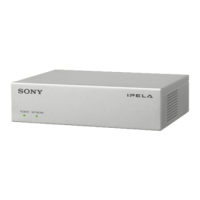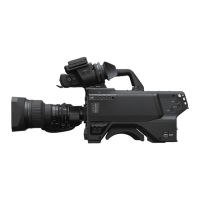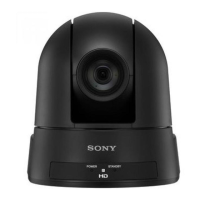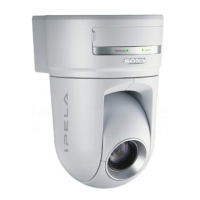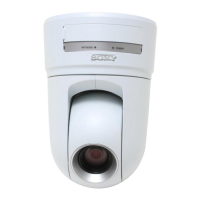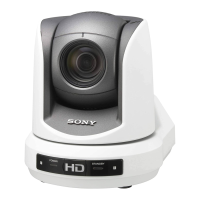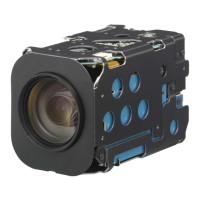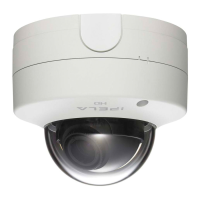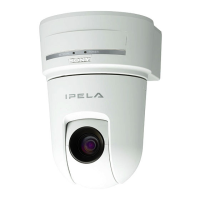Do you have a question about the Sony G65 and is the answer not in the manual?
Warning against opening the unit to prevent electric shock and ensure user safety.
Instructions on careful handling and proper cleaning methods to prevent damage.
Specifies operating temperature, humidity, and power source ratings for indoor/outdoor models.
Cautions against sunlight and water exposure to prevent damage and maintain image quality.
Advises adherence to electrical safety standards and proper installation orientation.
Warning against touching the cover to prevent scratches and maintain image quality.
Lists primary features like pan/tilt range, module support, presets, and connectivity options.
Details sensor type, resolution, and imaging features like Auto-Focus and WDR.
Explains internal temperature monitoring and protection mechanisms for reliable operation.
Lists advanced features like proportional pan and power-up actions for enhanced usability.
Lists components included for the Indoor Type 1 and Type 2 models.
Lists components included for the Outdoor Type 1 model.
Critical warning about handling the sensitive transparent cover to prevent damage and ensure image quality.
Instructions on how to carefully unpack the speed dome unit.
Essential safety guidelines to follow before commencing installation.
Prohibits installation in hazardous environments and near high-voltage sources.
Requirement to comply with local electrical codes and proper grounding procedures.
Advises using correct power sources, careful cable handling, and recommended cable types.
Emphasizes lightning-proof measures, IP66 rating, and protecting from water exposure.
Advises verifying the installation environment can support the appliance's weight and space needs.
Details the wiring cables and their connectors for power, video, and I/O interfaces.
Explains how to connect optional accessories for enhanced functionality and compatibility.
Describes RS485 serial communication for telemetric control, including transmission distance factors.
Explains the star-form connection method for multiple domes over longer distances.
Details recommended coaxial cable specifications and maximum transmission lengths.
Step-by-step instructions for installing the core unit onto the base board.
Lists various bracket accessories available for indoor and outdoor installations.
Describes the initial status and operational screens, including displayed information.
Explains how to control the dome's PTZ functions via keyboard, multiplexer, or DVR.
Introduces the OSD menu, how to access it, and navigate its main menu structure.
Explains the meaning of symbols and indicators used within the OSD menu interface.
Lists conditions under which entering the OSD menu might not be possible.
Section for modifying operation and display settings like dome label and temperature display.
Instructions on how to edit and assign a custom label to the dome camera.
Displays current settings such as firmware version, protocol, and communication parameters.
Controls the display of on-screen information like dome label, zoom, zone, and direction.
Configures motion-related features like auto-flip, proportional pan, park actions, and power-up actions.
Accesses advanced settings for camera modules, including image stabilization and focus.
Options to clear settings or reset the camera to factory defaults, with a warning about data loss.
Procedure to change the OSD menu access password, defaulting to 000000.
Sets the camera's internal clock, which is required for certain functions like Auto-Tracking.
Configures camera module settings such as zoom speed, digital zoom, and backlight compensation.
Advanced camera settings including IR CUT filter, exposure compensation, mirror, and flip functions.
Advanced settings for progressive scan, zoom, noise reduction, and image quality adjustments.
Configures PTZ functions like presets, auto scan, tours, and patterns for automated operation.
Manages up to 128 preset points, including setting, saving, and editing their labels.
Configures and runs scan functions between two predefined points, including setting limits and speed.
Records and plays back user-defined PTZ movements as patterns, up to 180 seconds each.
Configures automatic tours, defines zones, and sets timed triggers for camera functions.
Enables and configures auto-tracking for people or objects, including sensitivity and zoom settings.
Configures privacy mask (window blanking) to hide specific areas from the video feed.
Manages alarm settings, defines actions for triggered alarms, and schedules alarm arming.
Explains how to set the dome's address and communication protocol using DIP switches.
Details the purpose of DIP switches for address representation, protocol, and baud rate settings.
Table mapping ID numbers to their corresponding switch numbers (Sw1) for address configuration.
Lists the binary switch configurations for setting specific address IDs on the device.
Table mapping ID numbers to their corresponding switch numbers (Sw1) for address configuration.
Lists the binary switch configurations for setting specific address IDs on the device.
Table mapping ID numbers to their corresponding switch numbers (Sw1) for address configuration.
Lists the binary switch configurations for setting specific address IDs on the device.
Table mapping ID numbers to their corresponding switch numbers (Sw1) for address configuration.
Lists the binary switch configurations for setting specific address IDs on the device.
Warning against opening the unit to prevent electric shock and ensure user safety.
Instructions on careful handling and proper cleaning methods to prevent damage.
Specifies operating temperature, humidity, and power source ratings for indoor/outdoor models.
Cautions against sunlight and water exposure to prevent damage and maintain image quality.
Advises adherence to electrical safety standards and proper installation orientation.
Warning against touching the cover to prevent scratches and maintain image quality.
Lists primary features like pan/tilt range, module support, presets, and connectivity options.
Details sensor type, resolution, and imaging features like Auto-Focus and WDR.
Explains internal temperature monitoring and protection mechanisms for reliable operation.
Lists advanced features like proportional pan and power-up actions for enhanced usability.
Lists components included for the Indoor Type 1 and Type 2 models.
Lists components included for the Outdoor Type 1 model.
Critical warning about handling the sensitive transparent cover to prevent damage and ensure image quality.
Instructions on how to carefully unpack the speed dome unit.
Essential safety guidelines to follow before commencing installation.
Prohibits installation in hazardous environments and near high-voltage sources.
Requirement to comply with local electrical codes and proper grounding procedures.
Advises using correct power sources, careful cable handling, and recommended cable types.
Emphasizes lightning-proof measures, IP66 rating, and protecting from water exposure.
Advises verifying the installation environment can support the appliance's weight and space needs.
Details the wiring cables and their connectors for power, video, and I/O interfaces.
Explains how to connect optional accessories for enhanced functionality and compatibility.
Describes RS485 serial communication for telemetric control, including transmission distance factors.
Explains the star-form connection method for multiple domes over longer distances.
Details recommended coaxial cable specifications and maximum transmission lengths.
Step-by-step instructions for installing the core unit onto the base board.
Lists various bracket accessories available for indoor and outdoor installations.
Describes the initial status and operational screens, including displayed information.
Explains how to control the dome's PTZ functions via keyboard, multiplexer, or DVR.
Introduces the OSD menu, how to access it, and navigate its main menu structure.
Explains the meaning of symbols and indicators used within the OSD menu interface.
Lists conditions under which entering the OSD menu might not be possible.
Section for modifying operation and display settings like dome label and temperature display.
Instructions on how to edit and assign a custom label to the dome camera.
Displays current settings such as firmware version, protocol, and communication parameters.
Controls the display of on-screen information like dome label, zoom, zone, and direction.
Configures motion-related features like auto-flip, proportional pan, park actions, and power-up actions.
Accesses advanced settings for camera modules, including image stabilization and focus.
Options to clear settings or reset the camera to factory defaults, with a warning about data loss.
Procedure to change the OSD menu access password, defaulting to 000000.
Sets the camera's internal clock, which is required for certain functions like Auto-Tracking.
Configures camera module settings such as zoom speed, digital zoom, and backlight compensation.
Advanced camera settings including IR CUT filter, exposure compensation, mirror, and flip functions.
Advanced settings for progressive scan, zoom, noise reduction, and image quality adjustments.
Configures PTZ functions like presets, auto scan, tours, and patterns for automated operation.
Manages up to 128 preset points, including setting, saving, and editing their labels.
Configures and runs scan functions between two predefined points, including setting limits and speed.
Records and plays back user-defined PTZ movements as patterns, up to 180 seconds each.
Configures automatic tours, defines zones, and sets timed triggers for camera functions.
Enables and configures auto-tracking for people or objects, including sensitivity and zoom settings.
Configures privacy mask (window blanking) to hide specific areas from the video feed.
Manages alarm settings, defines actions for triggered alarms, and schedules alarm arming.
Explains how to set the dome's address and communication protocol using DIP switches.
Details the purpose of DIP switches for address representation, protocol, and baud rate settings.
Table mapping ID numbers to their corresponding switch numbers (Sw1) for address configuration.
Lists the binary switch configurations for setting specific address IDs on the device.
Table mapping ID numbers to their corresponding switch numbers (Sw1) for address configuration.
Lists the binary switch configurations for setting specific address IDs on the device.
Table mapping ID numbers to their corresponding switch numbers (Sw1) for address configuration.
Lists the binary switch configurations for setting specific address IDs on the device.
Table mapping ID numbers to their corresponding switch numbers (Sw1) for address configuration.
Lists the binary switch configurations for setting specific address IDs on the device.
| Brand | Sony |
|---|---|
| Model | G65 |
| Category | Security Camera |
| Language | English |

